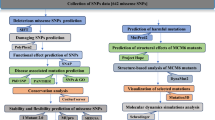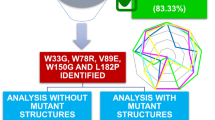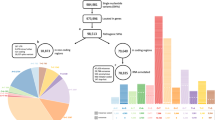Abstract
Single nucleotide polymorphism (SNP) technologies can be used to identify disease-causing genes in humans and to understand the inter-individual variation in drug response. These areas of research have major medical benefits. By establishing an association between the genetic make-up of an individual and drug response it may be possible to develop a genome-based diet and medicines that are more effective and safer for each individual. Additionally, SNPs can be used to understand the molecular mechanisms of sequence evolution. It has been found that throughout the given gene, the rate, type and site of nucleotide substitutions as well as the selection pressure on codons is not uniform. The residues that evolve under strong selective pressures are found to be significantly associated with human disease. Deleterious mutations that affect biological function of proteins are effectively being rejected by natural selection from the gene pool. If substituted nucleotides are fixed during evolution then they may have selection advantages, they may be neutral, or they may be deleterious and cause pathology. Therefore, it is possible that disease-associated SNPs (or pathology) and evolution can be related to one another.
Similar content being viewed by others
Log in or create a free account to read this content
Gain free access to this article, as well as selected content from this journal and more on nature.com
or
References
Ansari M, Krajinovic M (2007) Pharmacogenomics in cancer treatment defining genetic bases for inter-individual differences in responses to chemotherapy. Curr Opin Pediatr 19:15–22
Arbiza L, Duchi S, Montaner D, Burguet J, Pantoga-Uceda D, Pineda-Lucena A, Dopazo J, Dopazo H (2006) Selective pressures at a codon level predict deleterious mutations in human disease genes. J Mol Biol 358:1390–1404
Bao L, Cui Y (2005) Prediction of the phenotypic effects of non-synonymous single nucleotide polymorphisms using structural and evolutionary information. Bioinformatics 21:2185–2190
Bersaglieri T, Sabeti PC, Patterson N, Vanderploeg T, Schaffner SF, Drake JA, Rhodes M, Reich DE, Hirschhorn JN (2004) Genetic signatures of strong recent positive selection at the lactase gene. Am J Hum Genet 74:1111–1120
Bonafe L, Dermitzakis ET, Unger S, Greenberg CR, Campos-Xavier BA, Zankl A, Ucla C, Antonarakis SE, Superti-Furga A, Reymond A (2005) Evolutionary comparison provides evidence for pathogenicity of RMRP mutations. PLoS Genet 1:444–454
Chen K, Rajewsky N (2006) Natural selection on human microRNA binding sites inferred from SNP data. Nat Genet 38:1452–1456
Coelho M, Luiselli D, Bertorelle G, Lopes AT, Seixas S, Destro-Bisol G, Rocha J (2005) Microsatellite variation and evolution of human lactase persistence. Hum Genet 117:329–339
Couture P, Otvos JD, Cupples LA, Wilson PW, Schaefer EJ, Ordovas JM (1999) Association of the A-204C polymorphism in the cholesterol 7 alpha-hydroxylase gene with variations in plasma low-density lipoprotein cholesterol levels in the Framingham offspring. J Lipid Res 40:1883–1889
Couture P, Otvos JD, Cupples LA, Lahoz C, Wilson PW, Schaefer EJ, Ordovas JM (2000) Association of the C-514T polymorphism in the hepatic lipase gene with variations in lipoprotein subclass profiles: The Framingham Offspring Study. Arterioscler Thromb Vasc Biol 20:815–822
Dervieux T, Bala MV (2006) Overview of the pharmacoeconomics of pharmacogenetics. Pharmacogenomics 7:1175–1184
Emilien G, Ponchon M, Caldas C, Isacson O, Maloteaux J-M (2000) Impact of genomics on drug discovery and clinical medicine. Q J Med 93:391–423
Evans WE, Johnson JA (2001) Pharmacogenomics: the inherited basis for interindividual differences in drug response. Annu Rev Genomics Hum Genet 2:9–39
Foster CB, Aswath K, Chanock SJ, McKay HF, Peters U (2006) Polymorphism analysis of six selenoprotein genes: support for a selective sweep at the glutathione peroxidase 1 locus (3p21) in Asian populations. BMC Genet 7:56–63
Gilbert N, Boyle S, Fiegler H, Woodfine K, Carter NP, Bickmore WA (2004) Chromatin architecture of the human genome: gene rich domains are enriched in open chromatin fibers. Cell 118:555–566
Gray IC, Campbell DA, Spurr NK (2000) Single nucleotide polymorphism as tools in human genetics. Hum Mol Genet 9:2403–2408
Halushka MK, Fan JB, Bentley K, Hsie L, Shen NP, Weder A, Cooper R, Lipshutz R, Chakravarti A (1999) Patterns of single nucleotide polymorphisms in candidate genes for blood pressure homeostasis. Nat Genet 22:239–247
Hirschhorn JN, Daly MJ (2005) Genome-wide association studies for common diseases and complex traits. Nat Rev Genet 6:95–108
Iida A, Saito S, Sekine A, Mishima C, Kitamura Y, Kondo K, Harigae S, Osawa S, Nakamura Y (2002) Catalog of 605 single nucleotide polymorphisms (SNPs) among 13 genes encoding human ATP binding cassettes transporters: ABCA4, ABCA7, ABCA8, ABCD1, ABCD2, ABCD4, ABCE1, ABCF1, ABCG1, ABCG2, ABCG4, ABCG5 and ABCG8. J Hum Genet 47:285–310
Iida A, Saito S, Sekine A, Mishima C, Kitamura Y, Kondo K, Harigae S, Osawa S, Nakamura Y (2003) Catalog of 668 SNPs detected among 31 genes encoding potential drug targets on the cell surface. J Hum Genet 48:23–46
Jiang C, Zhao Z (2006) Mutational spectrum in the recent human genome inferred by single nucleotide polymorphisms. Genomics 88:527–534
Kehrer-Sawatzki H, Cooper DN (2007) Understanding the recent evolution of the human genome: insights from human–chimpanzee genome comparisons. Hum Mutat 28:99–130
Keightley PD, Gaffney DJ (2003) Functional constraints and frequency of deleterious mutations in non-coding DNA of rodents. Proc Natl Acad Sci USA 100:13402–13406
Kimchi-Sarfaty C, Oh JM, Kim I-W, Kim IW, Sauna ZE, Calcagno AM, Ambudkar SV, Gottesman MM (2007) A silent polymorphism in the MDR1 gene changes substrate specificity. Science 315:525–528
Kimura M (1983) The neutral theory of molecular evolution. Cambridge University Press, Cambridge, UK
Locke DP, Sharp AJ, McCarroll SA, McGrath SD, Newman TL, Cheng Z, Schwartz S, Albertson DG, Pinkel D, Altshuler DM, Eichler EE (2006) Linkage disequilibrium and heritability of copy-number polymorphisms within duplicated regions of the human genome. Am J Hum Genet 79:275–290
Martin N, Boomsma D, Machin G (1997) A twin pronged attacks on complex traits. Nat Genet 17:387–392
McLeod HL, Evans WE (2001) Pharmacogenomics: unlocking the human genome for better drug therapy. Annu Rev Pharmacol Toxicol 41:101–121
McVean G, Spencer CCA, Chaix R (2005) Perspectives on human genetic variation from the HapMap Project. PLoS Genet 1:413–418
Miller MP, Kumar S (2001) Understanding human disease mutations through the use of interspecific genetic variation. Hum Mol Genet 10:2319–2328
Nothen MM, Cichon S (2002) Linking single nucleotide polymorphisms. Pharmacogenetics 12:89–90
Ordovas JM, Mooser V (2004) Nutrigenomics and nutrigenetics. Curr Opin Lipidol 15:101–108
Ordovas JM, Corella D, Demissie S, Cupples LA, Couture P, Coltell O, Wilson PW, Schaefer EJ, Tucker KL (2002a) Dietary fat intake determines the effect of a common polymorphism in the hepatic lipase gene promoter on high-density lipoprotein metabolism: evidence of a strong dose effect in this gene–nutrient interaction in the Framingham study. Circulation 106:2315–2321
Ordovas JM, Corella D, Cupples LA, Demissie S, Kelleher A, Coltell O, Wilson PW, Schaefer EJ, Tucker K (2002b) Polyunsaturated fatty acids modulates the effects of the APOA1G-A polymorphism on HDL-cholesterol concentrations in a sex-specific manner: Framingham study. Am J Clin Nutr 75:38–46
Patterson N, Richter DJ, Gnerre S, Lander ES, Reich D (2006) Genetic evidence for complex speciation of humans and chimpanzees. Nature 441:1103–1108
Prendergast JGD, Campbell H, Gilbert N, Dunlop MG, Biackmore WA, Semple CAM (2007) Chromatin structure and evolution in the human genome. BMC Evol Biol 7:72–84
Ramensky V, Bork P, Sunyaev S (2002) Human non-synonymous SNPs: server and survey. Nucleic Acids Res 30:3894–3900
Reich DE, Cargill M, Bolk S, Ireland J, Sabeti PC, Richter DJ, Lavery T, Kouyoumijian R, Farhadian SF, Ward R, Landers ES (2001) Linkage disequilibrium in the human genome. Nature 411:199–204
Roden DM, Altman RB, Benowitz NL, Flockhart DA, Giacomini KM, Johnson JA, Krauss RM, McLeod HL, Ratain MJU, Relling MV, Ring HZ, Shuldiner AR, Weinshilboum RM, Weiss ST (2006) Pharmacogenomics: challenges and opportunities. Ann Intern Med 145:749–757
Roses AD (2000) Pharmacogenetics and the practice of medicine. Nature 405:857–865
Salisbury BA, Pungliya M, Choi JY, Jiang RH, Sun XJ, Stephens JC (2003) SNP and haplotype variation in the human genome. Mutat Res-Fund Mol Mech Mutagenesis 526:53–61
Saunders MA, Good JM, Lawrence EC, Ferrell RE, Li W-H, Nachman MW (2006) Human adaptive evolution of myostatin (GDF8), a regulator of muscle growth. Am J Hum Genet 79:1089–1097
Saunders MA, Liang H, Li WH (2007) Human polymorphism at microRNAs and microRNA target sites. Proc Natl Acad Sci USA 104:3300–3305
Sharp AJ, Locke DP, McGrath SD, Cheng Z, Bailey JA, Vallente RU, Pertz LM, Clark RA, Schwartz S, Segraves R, Oseroff VV, Albertson DG, Pinkel D, Eichler EE (2005) Segmental duplications and copy-number variation in the human genome. Am J Hum Genet 77:78–88
Shastry BS (2002) SNP alleles in human disease and evolution. J Hum Genet 47:561–566
Shastry BS (2003) SNPs and haplotypes: genetics markers for disease and drug response. Int J Mol Med 11:379–382
Shastry BS (2004) Role of SNP/haplotype map in gene discovery and drug development: an overview. Drug Dev Res 62:142–150
Shastry BS (2005) Genetic diversity and new therapeutic concepts. J Hum Genet 50:321–328
Shastry BS (2006a) Pharmacogenetics and the concept individualized medicine. Pharmacogenomics J 6:16–21
Shastry BS (2006b) Role of SNPs and haplotypes in human disease and drug development. In: Ozkan M, Heller MJ, Ferrari M (eds) Micro/nano technology in genomics and proteomics, vol II. Springer, New York, pp 447–458
Subbiah MT (2007) Nutrigenetics and nutriceuticals: the next wave riding on personalized medicine. Transl Res 149:55–61
Subramanian S, Kumar S (2006) Evolutionary anatomies of position and types of disease associated and neutral amino acid mutations in the human genome. BMC Genomics 7:306–312
Tang CS, Zhao YZ, Smith DK, Epstein RJ (2006) Intron length and accelerated 3′ gene evolution. Genomics 88:682–689
Trishkoff SA, Reed FA, Ranciaro A, Voight BF, Babbitt CC, Silverman JS, Powell K, Mortensen HM, Hirbo JB, Osman M, Ibrahim M, Omar SA, Lema G, Nyambo TB, Ghori J, Bumpstead S, Pritchard JK, Wray GA, Deloukas P (2007) Convergent adaptation of human lactase persistent in Africa and Europe. Nat Genet 39:31–40
Verdu P, Barreiro LB, Patin E, Gessain A, Cassar O, Kidd JR, Kidd KK, Behar DM, Froment A, Heyer E, Sica L, Casanova JL, Abel L, Quintana-Murci L (2006) Evolutionary insights into the high worldwide prevalence of MBL2 deficiency alleles. Hum Mol Genet 15:2650–2658
Vitkup D, Sander C, Church GM (2003) The amino acid mutational spectrum of human genetic disease. Genome Biol 4: R72-R80
Yang Z, Nlelsen R, Goldman N, Pedersen AM (2000) Codon substitution models for heterogeneous selection pressure at amino acid sites. Genomics 155:431–449
Zhang C, Bailey DK, Awad T, Liu G, Xing G, Cao M, Valmeekam V, Retief J, Matsuzaki H, Taub M, Seielstad M, Kennedy GC (2006) A whole genome long-range haplotype (WGLRH) test for detecting imprints of positive selection in human populations. Bioinformatics 22:2122–2128
Zhang C, Lopez-Ridaura R, Rimm EB, Rifai N, Hunter DJ, Hu FB (2005) Interaction between the -514 C to T polymorphism of the hepatic lipase gene and life-style factors in relation to HDL concentrations among US diabetic men. Am J Clin Nutr 81:1429–1435
Acknowledgments
My apologies to those whose work or original publications could not be cited in this short article because of space limitations.
Author information
Authors and Affiliations
Corresponding author
Rights and permissions
About this article
Cite this article
Shastry, B.S. SNPs in disease gene mapping, medicinal drug development and evolution. J Hum Genet 52, 871–880 (2007). https://doi.org/10.1007/s10038-007-0200-z
Received:
Accepted:
Published:
Issue date:
DOI: https://doi.org/10.1007/s10038-007-0200-z
Keywords
This article is cited by
-
Trace amine associated receptor 1: predicted effects of single nucleotide variants on structure-function in geographically diverse populations
Human Genomics (2024)
-
Chromosomal scale assembly reveals localized structural variants in avian caecal coccidian parasite Eimeria tenella
Scientific Reports (2023)
-
Com probe implemented STexS II greatly enhances specificity in SARS-CoV-2 variant detection
Scientific Reports (2023)
-
Template-jumping prime editing enables large insertion and exon rewriting in vivo
Nature Communications (2023)
-
Evolution of the human pathogenic lifestyle in fungi
Nature Microbiology (2022)



